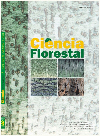
|
Ciência Florestal
Centro de Pesquisas Florestais - CEPEF, Departamento de Ciências Florestais - DCFL, Programa de Pós Graduação em Engenharia Florestal - PPGEF
ISSN: 0103-9954
EISSN: 0103-9954
Vol. 24, No. 4, 2014, pp. 1007-1016
|
 Bioline Code: cf14095
Bioline Code: cf14095
Full paper language: English
Document type: Research Article
Document available free of charge
|
|
|
Ciência Florestal, Vol. 24, No. 4, 2014, pp. 1007-1016
| pt |
ESTRUTURA E DISTRIBUIÇÃO ESPACIAL DE ANDIROBEIRAS (Carapa spp.) EM FLORESTA DE VÁRZEA DO ESTUÁRIO AMAZÔNICO
de Abreu, Jadson Coelho; Guedes, Marcelino Carneiro; Guedes, Ana Claudia Lira & Batista, Edmilson das Merces
Resumo
O objetivo geral deste trabalho foi avaliar se a densidade de ocorrência de andirobeiras é dependente da
distância do rio Amazonas, analisando sua distribuição espacial e a estrutura diamétrica da população em
um trecho de floretas de várzea no Estado do Amapá. Esse trabalho faz parte do projeto Florestam (Ecologia
e manejo florestal para uso múltiplo de várzeas do estuáario amazônico) e foi desenvolvido em uma área
de proteção ambiental (APA) de 136,59 ha, localizada no Distrito da Fazendinha, município de Macapá
- AP (00º03'04,24"S e 51º07'42,72"W). Foram lançados 3 transectos perpendiculares à margem do rio
Amazonas, distanciados entre si a cada 500 m, para orientar no direcionamento e localização das árvores.
Todas as andirobeiras com (CAP) circunferência a altura do peito ≥ 15 cm foram inventariadas e mapeadas,
anotando-se o (CAP) e o número da árvore em uma ficha de campo. A influência da distância do rio sobre a
densidade das andirobeiras foi analisada por regressão linear. O número de classes diamétricas foi definido
conforme Higushi. Foi testado o ajuste da distribuição dos diâmetros das andirobeiras ao modelo exponencial
de Meyer. Foi calculado o quociente q de De Liocourt, tanto para a frequêencia observada quanto para a
estimada. Calculou-se o índice de Morisita, variância/média e índice de agregação para se inferir sobre a
distribuição espacial. Foram inventariadas 680 andirobeiras produtivas e não produtivas, com uma área
basal de 55,84 m2, gerando uma densidade de 5 árvores ha-1. Quanto à distribuição diamétrica, foram geradas
9 classes de diâmetro com 11 cm de amplitude, sendo que o coeficiente de determinação para o modelo
exponencial foi de 0,93 e o quociente q = 2,03. Os índices utilizados mostraram que a distribuição espacial
das andirobeiras adultas ocorre de forma agregada. A estrutura diamétrica das andirobeiras mostra que há
elevada quantidade de regenerantes e que a população não está senescente. A densidade de andirobeiras
adultas é dependente da distância do rio, com maior concentração de árvores em áreas mais distantes do rio
Amazonas.
Palavras-chave
Amapá; distribuição diamétrica; distribuição agregada; Florestam
|
| |
| en |
STRUCTURE AND SPATIAL DISTRIBUTION OF ‘ANDIROBEIRAS’ (Carapa spp.) IN FLOODPLAIN FOREST OF THE AMAZON ESTUARY
de Abreu, Jadson Coelho; Guedes, Marcelino Carneiro; Guedes, Ana Claudia Lira & Batista, Edmilson das Merces
Abstract
The aim of this study was to evaluate whether the density of occurrence of andirobeiras is dependent of
the Amazon River distance, analyzing their spatial distribution and diameter structure of the population in
a floodplain forest in Amapá state, Brazilian Amazon. This work is part of ‘Florestam’ project (ecology
and forest management for the multiple use of the floodplains of the Amazon estuary).This study was
conducted in an environment protected area of 136.59 ha, located in Fazendinha district, city of Macapá, AP state (00º03'04,24"S e 51º07'42,72"W). Three transects perpendicular to the Amazon river were
launched, apart from each other every 500 m, to guide the direction and location of trees. All andirobeiras
with (CBH) circumference at breast height ≥ 15 cm were inventoried and mapped. The number of
diameter classes was defined according to Higushi. We tested the fit of andirobeira diameter distribution
to the exponential model by Meyer. We calculated the ratio q of De Liocourt for the observed and for the
estimated frequencies. We calculated Morisita index, variance/mean ratio, and aggregation to infer the
spatial distribution. Six hundred and eighty productive and unproductive andirobeiras were inventoried
with a basal area of 55.84 m2, generating a density of 5 trees ha-1.The diameter distribution were generated
with 9 classes of 11 cm diameter range and the determination coefficient for the exponential model was 0.93
and the quotient q = 2.03.The indices used showed that the spatial distribution of adult andirobeiras occurs
in the aggregate form. The andirobeira diameter structure shows great number of young individuals and that
the population is not senescent. The density of adult andirobeiras depends on the river distance, with the
greatest concentration of trees in more remote areas of Amazon River.
Keywords
Amapá; diameter distribution; aggregate distribution; Florestam
|
| |
© Copyright 2014 - Ciência Florestal
Alternative site location: http://cascavel.ufsm.br/revistas/ojs-2.2.2/index.php/cienciaflorestal/index
|
|
